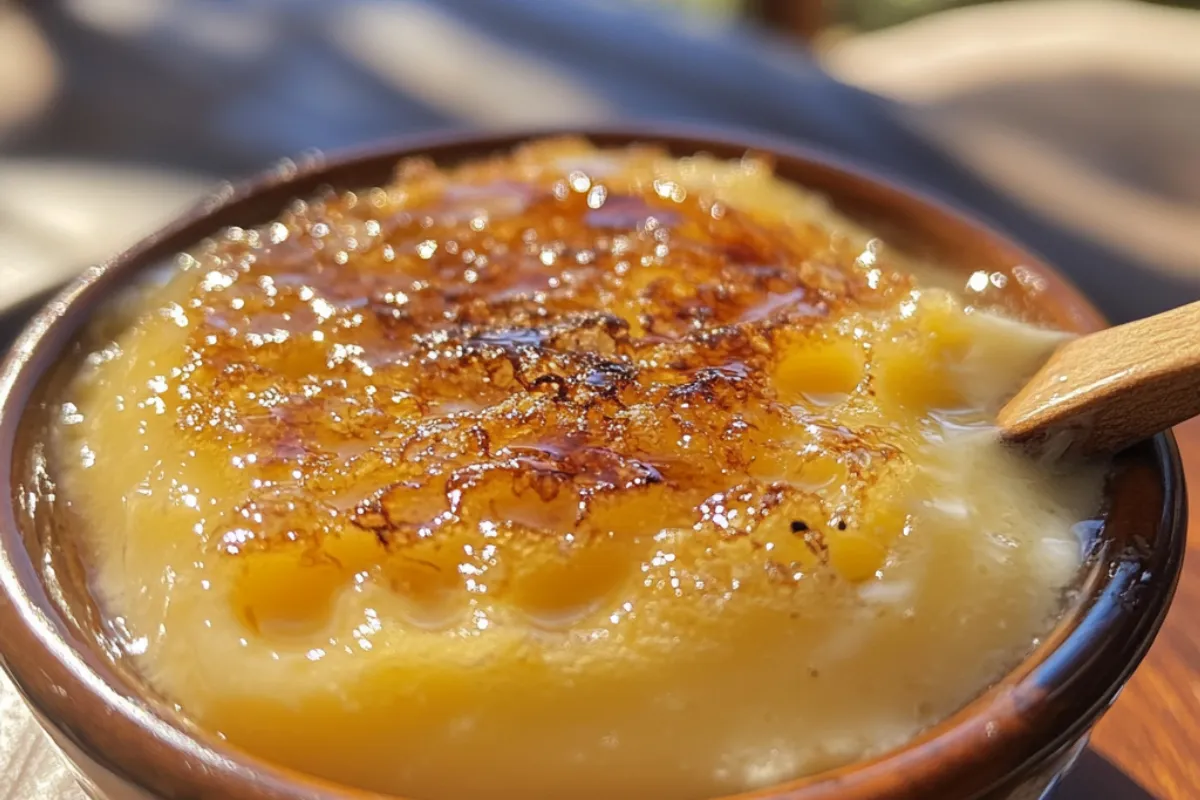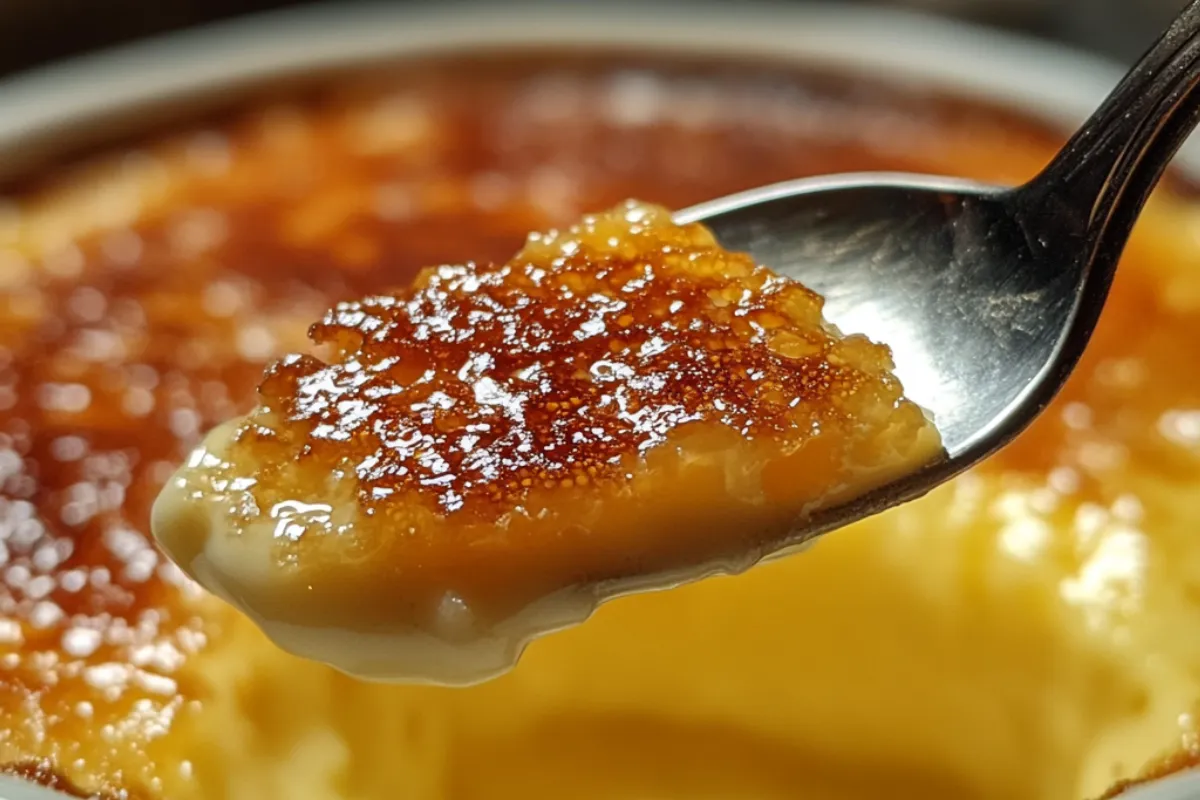When preparing the perfect crème brûlée, one of the key decisions is choosing the right type of sugar for that signature caramelized crust. This seemingly small detail, however, can make a significant difference in the final texture and flavor of the dessert. In this article, we’ll delve deep into the best sugar options for crème brûlée, discuss how to achieve the ideal caramelization, and explore some common mistakes to avoid. By the end, you’ll be well-equipped to create a flawless dessert every time.

What is Crème Brûlée?
Crème brûlée is a classic French dessert, known for its creamy custard base and caramelized sugar top. The contrast between the rich, velvety custard and the crunchy sugar crust is what makes this dessert so beloved. The word “brûlée” literally means “burnt,” referring to the burnt sugar layer on top of the custard.
To achieve that perfect sugar topping, choosing the right sugar for brûlée is essential, as it directly influences how well the sugar caramelizes and the final texture of the dessert.
Best Sugar for Crème Brûlée
Choosing the right sugar is crucial for the caramelization process. While there are several types of sugar available, not all of them work well for creating that ideal crunchy top. Let’s explore the best options for brûlée:
- White Granulated Sugar: This is the most commonly used sugar for crème brûlée. It caramelizes evenly and creates a thin, crisp layer. The fine granules melt quickly, ensuring an even caramelization.
- Superfine or Caster Sugar: This sugar is even finer than granulated sugar, which makes it ideal for brûlée. It melts quickly and evenly, providing a smooth, glass-like caramelized layer. Many chefs prefer superfine sugar for this reason.
- Turbinado or Demerara Sugar: These are raw sugars with larger crystals. While they offer a more intense, molasses-like flavor, they don’t caramelize as evenly as granulated or superfine sugar. The larger granules can result in a thicker, crunchier layer, which some people enjoy, but others may find too hard.
For more information on the best sugar for crème brûlée, check out this comprehensive guide on caramelization. Understanding how sugar granules melt and form the perfect crust is key to mastering this dessert.
The Ideal Caramelization Process
The process of caramelizing the sugar on top of crème brûlée is what gives it its iconic appearance and texture. When done correctly, the sugar melts and hardens into a glassy, brittle layer that contrasts beautifully with the creamy custard beneath.
To achieve the ideal caramelization:
- Evenly Spread the Sugar: Whether you’re using granulated or superfine sugar, be sure to spread an even layer over the custard. This ensures that the sugar melts uniformly.
- Use a Culinary Torch: A torch gives you more control over the caramelization process. By directing the flame over the sugar, you can caramelize it without overheating the custard underneath.
- Keep it Moving: When using a torch, keep the flame moving constantly to avoid burning any one spot. The goal is to melt the sugar evenly, creating a uniform caramelized top.
You can also achieve this effect using a broiler, but it requires more careful monitoring. For tips on perfecting the caramelization process, visit this step-by-step guide.

Common Mistakes When Caramelizing Sugar
Even experienced cooks can run into trouble when caramelizing sugar for crème brûlée. Here are some common mistakes to avoid:
- Over Caramelization: It’s easy to overdo it with the torch or broiler. If the sugar burns too much, it can taste bitter and ruin the dessert. Watch carefully as the sugar melts, and remove the heat as soon as it turns golden brown.
- Uneven Sugar Layer: If the sugar isn’t spread evenly, some parts may caramelize too quickly while others remain underdone. This can result in an inconsistent texture.
- Using the Wrong Sugar: Not all sugars are suitable for brûlée. Sugars with large crystals, such as turbinado or raw sugar, can create a crust that’s too thick or doesn’t caramelize evenly.
How Much Sugar to Use?
The amount of sugar you use for the top of crème brûlée can make a big difference in the final texture. Too much sugar will result in a thick, hard crust that can be difficult to crack, while too little sugar may not form a proper caramelized layer.
- Ideal Amount: For a standard serving of crème brûlée, about 1 to 1.5 teaspoons of sugar per ramekin is recommended. This provides just the right amount to create a thin, crisp crust without overpowering the delicate custard beneath.
Sugar Alternatives for Crème Brûlée
If you’re feeling adventurous, you might wonder if alternative sugars can work for crème brûlée. Here’s a quick guide to some popular alternatives and how they fare:
- Brown Sugar: Brown sugar adds a deep, caramel-like flavor, but it also has a higher moisture content, which can make it harder to achieve a crisp layer. It’s possible to use brown sugar, but it requires more careful caramelization to avoid burning.
- Coconut Sugar: A popular alternative for health-conscious bakers, coconut sugar has a lower glycemic index and adds a unique, earthy flavor. However, it also tends to burn more quickly, so you’ll need to watch it closely if using a torch.
While these alternatives can provide interesting flavor variations, they may not deliver the same perfect crust as granulated or superfine sugar.
Tools for Caramelizing Sugar
To achieve that perfectly caramelized top, you’ll need the right tools:
- Blow Torch: This is the preferred method for caramelizing sugar on crème brûlée. A small kitchen blow torch gives you the control needed to evenly caramelize the sugar without overheating the custard.
- Broiler: If you don’t have a torch, you can use your oven’s broiler to caramelize the sugar. However, this method requires careful monitoring, as the heat from the broiler can warm the custard.
- Sugar Sifter: A sugar sifter can help you spread an even, fine layer of sugar over the custard, ensuring consistent caramelization.

FAQs: Sugar for Crème Brûlée
What type of sugar is best for crème brûlée?
The best sugar for crème brûlée is superfine sugar or granulated sugar. These sugars melt evenly and provide a smooth, glassy caramelized top.
Can you use brown sugar for crème brûlée?
Yes, you can use brown sugar, but it’s trickier to caramelize due to its higher moisture content. It may require more careful torching to avoid burning.
Is powdered sugar good for crème brûlée?
No, powdered sugar is not recommended for crème brûlée. It tends to clump and does not caramelize evenly, resulting in a patchy crust.
What is the best way to caramelize sugar on crème brûlée?
Using a culinary torch is the best method for caramelizing sugar. It allows you to control the heat and ensure an even caramelization without overheating the custard.
Final Thoughts
Choosing the right sugar for your crème brûlée is essential to achieving the perfect dessert. While granulated and superfine sugar are the top choices for most recipes, you can experiment with turbinado or even coconut sugar for a twist on the classic flavor. Just remember to watch your caramelization carefully and spread the sugar evenly for the best results.
Whether you’re preparing this elegant dessert for a dinner party or simply indulging in a sweet treat, mastering the sugar topping is the key to success.
Conclusion
In conclusion, mastering the art of caramelizing sugar for *crème brûlée* is essential for achieving the perfect balance between a creamy custard base and a crisp, caramelized topping. By carefully selecting the right type of sugar—whether it be *granulated sugar*, *superfine sugar*, or even experimenting with *turbinado sugar*—you can create a dessert that not only tastes incredible but also has the ideal texture.
Throughout this guide, we’ve explored various types of sugar, discussed the importance of even caramelization, and highlighted common mistakes to avoid. Whether you’re using a *culinary torch* or a *broiler*, it’s essential to control the heat and pay attention to the sugar’s melting process to avoid burning or under-caramelizing. Additionally, we’ve touched on alternative sugars like *brown sugar* and *coconut sugar*, which can add interesting flavors but come with their own set of challenges.
Ultimately, the type of sugar you choose will depend on the flavor and texture you want to achieve. However, the most important aspect is to ensure that the sugar is evenly spread and carefully caramelized to create that signature, crackable top.
By keeping these tips and techniques in mind, you’ll be able to create a *crème brûlée* that impresses both visually and in taste. Whether you’re making this classic French dessert for a special occasion or just indulging at home, you’ll now have the confidence to achieve that perfect caramelized sugar layer every time.
So, gather your ingredients, prep your blow torch, and enjoy the process of creating a delicious and beautiful *crème brûlée* with the perfect sugar crust!

